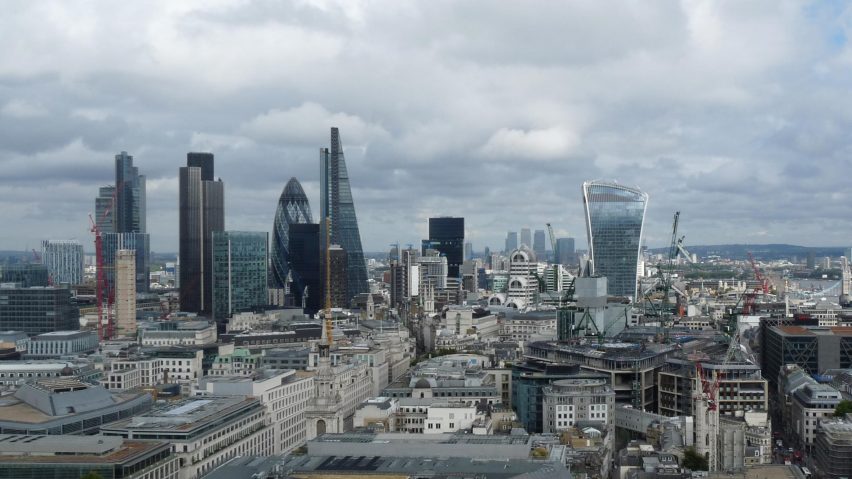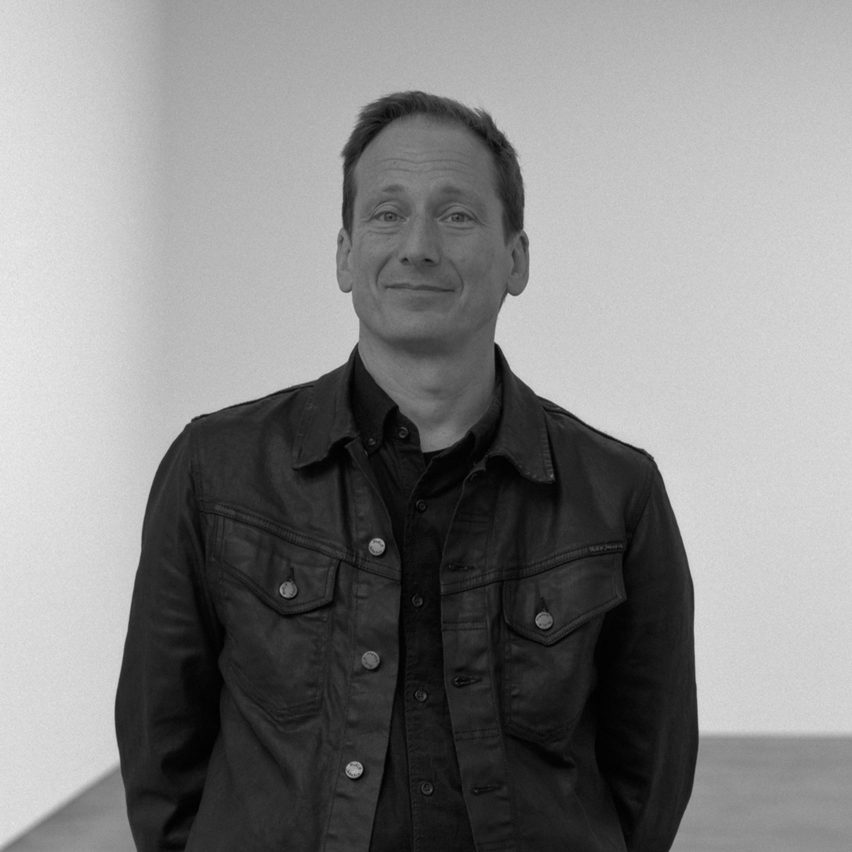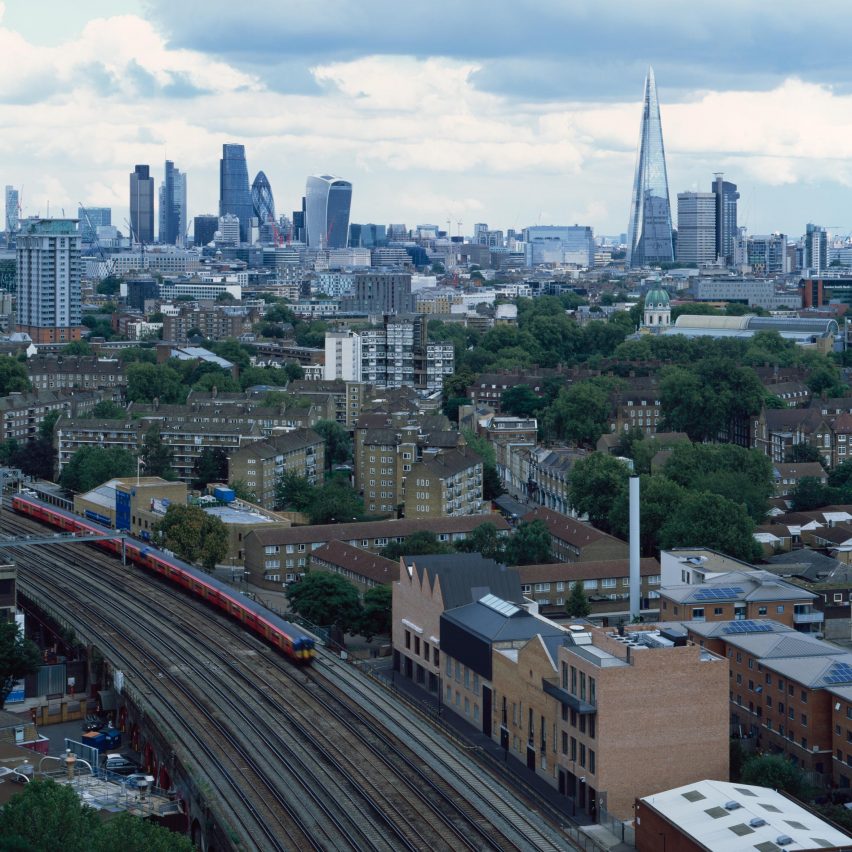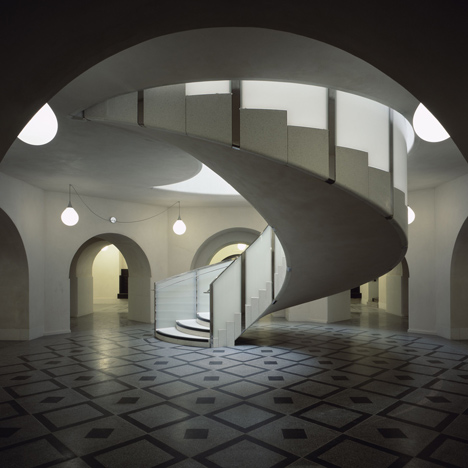
"London is looking more and more like Dubai" says architect Adam Caruso
The lack of regulation over London's new architecture has turned the city into a "free for all", according to Adam Caruso, one of the architects behind the Stirling Prize-winning Newport Street Gallery.
Caruso – one of the co-founders of London studio Caruso St John – said that property developers hold too much power over the design and planning of his home city, and that opportunities have been missed as a result.
"In Britain, there's no authority; it is a free for all. That is why London is looking more and more like Dubai," he said.
"I think it is a shame because with the money invested you could have done much more for the city with almost the same profit."

Caruso St John has been in practice for over 26 years, but has only completed a handful of projects in the UK capital. Among these is the renovation of Tate Britain and the Newport Street Gallery for artist Damien Hirst.
According to Caruso, the firm is keen to work on more commercial projects, but rarely gets these kinds of commissions in the UK. He claims the planning system is more effective in countries like Germany, where the appointed city architects have more power than developers.
"We have been around for quite a while and have had success, and yet we are still slightly marginal on the British scene," he said.
"Generally, we get projects through competitions," he continued. "In Germany, the city architect is very important. If he says, 'It doesn't matter whether it is a developer project, this is important for the city, there has to be a competition,' then there is one."
"In Britain, we really tried to do commercial buildings, but there the developer pays, and the developer decides."

Caruso St John ranked at number 58 on the inaugural Dezeen Hot List – a countdown of the key forces and emerging players in architecture and design from around the world.
Caruso made the comments at an exhibition of the firm's unrealised projects, held at the Gallery of Contemporary Art in České Budějovice, in the Czech Republic.
In the interview, the architect also revealed that – while the studio is often praised for its careful approach to working with historic buildings – Caruso St John avoids being too precious with renovations.
"When we are working with existing buildings, we are not super-sensitive," he said.

He said his aim with projects like Newport Street Gallery is to avoid creating a distinction between old and new, even if heritage authorities disagree, and instead worry about creating a successful whole.
"I think, especially in Europe, the coexistence of old and new fabrics in one building is and will become an even bigger topic in the future," he said.
"For the Newport Street Gallery, we did this new Bart Simpson haircut part. It was not about being sensitive or deferential to the existing fabric; it was about making a strong formal statement, and it became the logo for the gallery."
Read on for the full interview conducted by Filip Šenk, reporting for Dezeen from the Czech Republic.
Filip Šenk: It was great to see you win the RIBA Stirling Prize last year. What is your view of such an award?
Adam Caruso: We were shortlisted twice before. To win always has to do with who is on the jury, and it has a lot to do with politics. Like every awards system, many of the best projects never get the big prize. But of course, we were very happy to receive it. It represents recognition from your profession that you have done something good. It's officially awarded for one building, but obviously it is also for a body of work. Still, we were pleased and quite surprised. We have been around for quite a while – 26 years – and have had success, and yet we are still slightly marginal on the British scene.
Filip Šenk: Do you really feel marginalised, despite winning the Stirling Prize?
Adam Caruso: Yes, we have very little work in Britain at the moment. The majority of the work of our London office is in Germany, Sweden and Flanders, and we have a very busy Swiss office. Of course, we have great clients in Britain, like the Tate, Larry Gagosian and Damien Hirst. But somehow we are a bit to the side.
Filip Šenk: Do you have any explanation for this?
Adam Caruso: Generally, we get projects through competitions. In Germany, the city architect is very important. If he says, "It doesn't matter whether it is a developer project, this is important for the city, there has to be a competition", then there is one.
In Britain, we really tried to do commercial buildings, but there the developer pays, and the developer decides. They are not really interested in working with us because we haven't spent the past 15 years building up useful social contacts. The reason why we don't have much work in Britain has a lot to do with how the projects are awarded.
We are still slightly marginal on the British scene
Filip Šenk: So the reason why you have work on the Continent and not in Britain is the existence of a city authority overlooking the city development?
Adam Caruso: In Britain, there's no authority; it is a free for all. That is why London is looking more and more like Dubai. There is no mystery about that. I think it is a shame because with the money invested you could have done much more for the city with almost the same profit. It is about the will to cooperate. You can still get the money you invested back and create something for the greater good.
Filip Šenk: Your approach to architecture is based on a strong respect for the place and history of architecture. In the case of the Newport Street Gallery, which you did for Damien Hirst and for which you were awarded the Stirling Prize, you worked with three listed buildings. Could you explain your intentions?
Adam Caruso: We have done many projects in existing buildings, but this is not because it is our big interest. Somehow, we fell into it. But you could argue we fell into it because we are really interested in the history of architecture. When we are working with existing buildings, we are not super-sensitive. We try to do what is correct and also to do something that engages the historical fabric – like Jože Plečnik's work in Prague Castle. He wasn't being a shrinking violet, he was being Plečnik: a difficult but amazing designer. And he is a model for us, how we approach work in existing buildings.
With the Newport Street Gallery, there were three existing scenery painting workshops, and we did a lot to them. On either side of the three, there were less important buildings, which we demolished. For us, the project was to make a completely new whole that is made with existing and new fabric.
When you are outside or inside the building, you can't really see where the joints are. That goes against the orthodoxy of how you work with existing buildings, because the Venice Charter and all of the charters that came out of ICOMOS claim you should accentuate the differences. But my view is if you look at buildings like the Canterbury Cathedral, buildings that have been built over many years, in the end they become something whole. As in the Tate Britain project, we had no problem with the heritage authority because they understood what we were doing. They trusted us.
Sometimes we do have trouble, because heritage conservationists want us to make the difference clear. Because we make it ambiguous, they have difficulty discussing it with us. But more often than not it has been a good relationship.
In Britain, there's no authority; it is a free for all
Filip Šenk: I think, especially in Europe, the coexistence of old and new fabrics in one building is and will become an even bigger topic in the future because it is a way to prevent endless urbanisation, like in the north of Italy. And yet, I believe Carlo Scarpa showed great insight in adding new fabrics to old ones while the difference is clear, and yet it creates a complex unity.
Adam Caruso: That's a previous generation. When I discovered Scarpa as a student, he was a revelation to me. But I would say that his approach has become something of an orthodoxy of how to combine the new and the old. What I still like about Scarpa is how bold he was in working with historical fabrics.
For the Newport Street Gallery, we did this new Bart Simpson haircut part. It was not about being sensitive or deferential to the existing fabric; it was about making a strong formal statement, and it became the logo for the gallery.
Filip Šenk: As I understand it, the Newport Street Gallery can be understood as sort of a sum total of your experience with gallery design.
Adam Caruso: Some years ago, we did the Nottingham Contemporary project. That was a new building, but our concept was to create a building that had the variety that an existing industrial building would have. It was for contemporary art production; it was for both live art and visual art. When the Tate was beginning to think about Tate Modern, it had a group of artists who visited many contemporary art institutions. In the end, it came up with some principles, and one of the things that emerged was that for almost all of the artists their favourite exhibition spaces were in buildings that previously hadn't been gallery spaces. That tells you something.
It also implies that the previous life of a building is a quality: There's a kind of energy or aura that gives the artist and the art something to connect to. I'm talking about contemporary art. Contemporary artists don't just make works that curators then hang somewhere. We were always interested in creating places where there is an identity, but within the identity there's quite a range of spaces.
Walsall, which was the first big gallery project we did, already had that. This came from our interest in existing buildings that would be converted. With the Newport Street Gallery, it is half and half: Each gallery has a slightly different shape and size, but although they are different, what is really important is that there's enough continuity. You can do one show, but you can also do three shows.
If you have a gallery with eight identical rooms, it is very difficult to do a show. Every time you enter a room, it is the same thing. So far, there have been two very different shows in the Newport Street Gallery, and both worked very well.
Filip Šenk: It is often said the most important thing is how you are able to handle natural light.
Adam Caruso: I disagree. I think that is an old fashioned idea that is not always relevant. If you are doing a classical 19th-century historic painting gallery, top-light is good. However, top-light can become very monotonous because it is rather flat and doesn't change that much. If you do a gallery for abstract expressionists, you could have natural light, but Rothko, for example, worked mainly during the night, and his works were meant for collectors who would put them in small spaces. They were not meant to be in huge spaces full of natural light. Top-light is good, but it is not the only way.
When we are working with existing buildings, we are not super-sensitive
Filip Šenk: And yet, Kahn's Kimbell Art Museum has beautiful top-light and is an icon of 20th-century gallery design.
Adam Caruso: True. I've just been to the Kimbell, and the light is very beautiful. But because it is in the States, they always have the artificial lights on. The natural light is very blue, and the artificial very red, and the result is a bit weird. I really wanted to ask them to turn the artificial lighting off.
I think a variety of light is quite important. A 19th-century gallery like the KHM in Vienna by Semper has classic top-lit galleries and cabinet galleries with windows. It was always about a certain variety.
Filip Šenk: Many philosophers and art theoreticians believe galleries are in a way the churches of our era. Do you consider the "spiritual" during your design process? Does this idea affect your design at all?
Adam Caruso: I guess it is true. But we don't think about anything spiritual. Galleries are really important because they are public spaces. In the contemporary world, the public realm is under continuous threat. The possibility of opening a public gallery – or, with someone like Damien Hirst, a private gallery that works like a public one – and welcoming people in is great and, if it is free, even better. You can come in see the exhibition, and then sit down and have a coffee. That is what is exciting for us about doing a gallery.
I also think contemporary art is not about the spiritual but about telling the viewer something about the world, contemporary art is special in its engagement with the real world. Contemporary art tells us as much about the contemporary condition as science does, although in mainstream political discourse it is never given the status it deserves. It tells us where we are in the world. It helps us understand what is happening. It is not about an escape in the way religion is, and I'm not antispiritual, but contemporary art it is focused on the here and now.
When you go to a Fischli/Weiss show, it is so funny and so engaging. It makes you laugh, but it is also profound. They are opening my eyes to look at things that at first glance seemed so ugly and unpromising.
When we started our practice, Richard Serra, Gordon Matta-Clark and others were great influences. We looked at their work and the character of London, which was ugly and aggressive, and through their work, found beauty in it.
Filip Šenk: But it doesn't mean you are making art instrumental, as some rather naïve books and authors try to do nowadays?
Adam Caruso: I learn from art, and I can use art instrumentally because I'm a cultural producer, and I copy things I see at shows. I'm totally open about it. In this exhibition in České Budějovice, we have 50 references in our first room, and we could have had 50 or even 100 more. Those are the things we looked at over the years and stole from. But when an architect or an artist steals, that's how art has always been created. If you do it and make it your own, that is how art moves on. You see something, you are affected, and you try to understand how it works, and then you make your version of it. And it may result in a mistake. For instance, Fischli/Weiss are full of mistakes. Artists instrumentalise art, for sure, but it is not didactic.
For a really good project, you need a client who pushes you and trusts you
Filip Šenk: You say you aim for complexity that cannot be understood after just one visit to the house.
Adam Caruso: Hopefully! Otherwise, what's the point of building it!?
For good architecture, the client is very important. For a really good project, you need a client who pushes you and trusts you. If you form a good working relationship, the architect and the client end up with something that is beyond what they initially hoped for.
When we visit a recently completed project, we find what we expected, because we planned the building very carefully, but there are other things that you never expected. That is almost the only reason to build, because building is very complex and difficult.
With galleries, you have a programme that you think the gallery is going to have. Inevitably, one year later, they do something else, and the gallery is able to accommodate that new programme. Some artists absolutely ruin the gallery, and I love that because they found the hidden potential of the building.
Filip Šenk: And how is your work with Peter St John after 26 years of practice?
Adam Caruso: We manage, like an old married couple. At the beginning, it was very intense, as there were only the two of us. But as we grew, we added collaborators, which helps.
We don't work on everything so intensely together, although we still work on a lot of things together. It is nice to work with someone else because it removes ego issues. It doesn't matter where the idea comes from. It really doesn't matter whose idea it is. In the end, what matters is what you do with the ideas. I see some famous architects doing all the sketches themselves because they believe they have to do that. I actually think that is the recipe to make your architecture narrow.
Architecture has always been a discussion, and in our office when we review projects everyone is allowed to say what they think. In our office, you don't have to be cynical. We can believe in what we are doing.